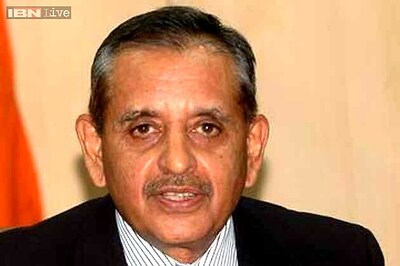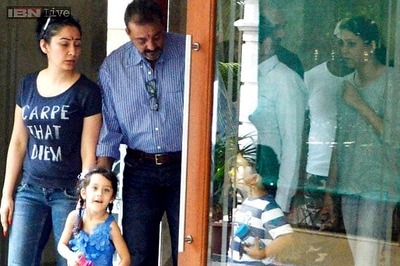
views
A decisive election result has spurred hopes for a kick-start to the development of India’s notoriously poised infrastructure. Indian infrastructure investment equaled about 6% of the gross domestic product (GDP) last year compared with 8.5% in China.
Also, hopes are high that the Budget to be unveiled on July 6 will include commitments to speed up infrastructure development from the rationalisation of taxes, to the tax intensive for infrastructure funding for the next 10 years, to the removal of minimum alternate tax (MAT), to rationalisation of indirect tax benefits India Inc has a long wish list.
Exclusively on CNBC-TV18, Chairman, CII National Council on Infrastructure, Vinayak Chatterjee and Chairman, Feedback Ventures, Athar Shahab, Chairman, CII Core Group on Roads and Deputy MD, IDFC Projects, and Chairman, CII Core Group on Airports and President and CEO, Mumbai International Airport, Rajeev Jain discuss how imperative is infrastructure in the forthcoming Budget.
Chairman, CII National Council on Infrastructure Vinayak Chatterjee and Chairman, Feedback Ventures, said CII’s wish list is divided into three baskets. “The Budget for infrastructure is fundamentally at interplay between these three baskets—taxation, financial markets and direction setting,” he said.
“One is getting feelers from the ground that revenue considerations and potential loss of revenue will not allow the government to actually give some tax concessions or benefits that might lead to potential loss of revenues, although they may agree that it is logical to do so,” he added,
However, Chairman, CII Core Group on Roads and Deputy MD, IDFC Projects, Athar Shahab was a little more hopeful on this count. “The multiplier effect of infrastructure is very obvious and we are seeing that in sectors like telecom, where there is work, everybody knows that if one can give a similar kick-start to industries like power and roads and so on, the whole economy would benefit tremendously.
Therefore, rather than looking at a very narrow perspective of today’s revenue collection in this year or the year after this, probably is not the right way and I think there is a school of thought that believes that some kind of impetus may be necessary,” he said.
Commenting on the rationalisation of section 88 IA and removal of MAT for infra, Chairman, CII Core Group on Airports and President and CEO, Mumbai International Airport, Rajeev Jain said, “88 IA is a section where sunset clause has already set in on so many industries and only two to three industries are there which are now eligible for 88 IA and MAT is not gelling with that. You are exempted under 88 IA but you have to pay MAT. I am hoping that some correction should come in 88 IA. We are quite hopeful that MAT should be abolished at least for infrastructure projects—10 (23G) also—something like that should come in this Budget.”
Here is a verbatim transcript of the exclusive interview with Vinayak Chatterjee, Athar Shahab and Rajeev Jain on CNBC-TV18.
Q: Let me start by asking you—every year we put this question to all of you on the panels like this and the question this time around is that there is so much expectation, given the fact that you have got a decisive election result and the hope really is that infrastructure is going to be given top priority. How hopeful are you this time around and how different are you feeling from last year?
Chatterjee: Not too different from last year because even at this time last year, or Budget time last year, quite honestly the hopes and expectations on infrastructure were equally high as they are this time. But to go straight to chase and you have CII’s long wish list with you which is many pages. I think the idea really is to segregate them into some manageable baskets and I think this time I am going to segregate them into three baskets. Basket one relates to all the issues relating to taxation and you read out a few of them. Basket two are issues that impact financial market or make getting finance for infrastructure projects easier or more difficult, nothing to do with taxation but a series of measures. Basket three is to do with what one broadly calls direction setting—announcement of new plans and programmes like Bharat Nirman etc.
Now the Budget for infrastructure is fundamentally at interplay between these three baskets—taxation, financial markets and direction setting.
Q: So which basket do you actually think will find its way into the Budget? How hopeful are you that actually the tax incentives part or the tax bucket of it will form a large chunk of the Budget this year for you?
Chatterjee: Hope and expectation from the infrastructure sector is that it will be impactful but one is also getting feelers from the ground that revenue considerations and potential loss of revenue will not allow the government to actually give some tax concessions or benefits that might lead to potential loss of revenues although they may agree that it is logical to do so. So therefore the expectation is a little tempered on that count.
Q: Would you agree with that, that revenue neutral policies are probably going to find their way into this Budget—so don’t really expect great tax sops, don’t really expect great tax concessions—is that the hope that your picking up as well at this point?
Shahab: I would say I am a little more hopeful than Chatterjee is.
Q: What's the reason behind that optimism?
Shahab: The multiplier effect of infrastructure is very obvious and we are seeing that in sectors where there is work like telecom and everybody knows that if one can give a similar kick start to industries like power and roads and so on, the whole economy would benefit tremendously and therefore rather than looking at a very narrow perspective of today’s revenue collection in this year or the year after this, probably is not the right way and I think there is a school of thought that believes that some kind of impetus may be necessary.
Q: Let us look at the look at the long list that CII has put up in terms of recommendations that are on the tax front. Rationalisation of section 88 IA, extension for another 10-years, provision of tax incentives for infra funding for the next 10-years like 10 (23G) and removal of MAT for infra for the next 10 years. How much of this do actually see getting done this Budget?
Shahab: If you see 88 IA and MAT – they just gel together – they are contrary to each other and industries has been saying for a long time, please these don’t go together. If you want to encourage infrastructure do away with MAT. And we believe that this time around the government would listen. 10(23G) when it was introduced it was a great incentive to infrastructure financing – various reasons the government decided to withdraw this. Bring something like that back into infrastructure, it gives a kick start – it sends the right signal. Then the whole casketing impact of dividend distribution tax – infrastructure investment routed through multilayered vehicles. You cannot afford to have tax leakages at each layer, so things like that. If the government is sensitive, if they really want to push – these are very important signals. May be short-term view could be a little bit of revenue leakage but the long-term view is very positive.
PAGE_BREAK
Q: Do you actually see them biting the bullet in the short-term even if it means taking on a revenue hit? Do you actually see them correcting the anomalies—the long standing demand of industry on issues like MAT for instance?
Jain: Yes I agree with Shahab. I think 88 IA is a section where sunset clause has already set in on so many industries and only 2-3 industries are there which are now eligible for 88 IA and MAT is not gelling with that. You are exempted under 88 IA but you have to pay MAT. I am hoping that some correction should come in 88 IA. We are quite hopeful that MAT should be abolished at least for infrastructure projects – 10 (23G) also – something like that should come in this Budget.
Q: Outside of incentives for infra funding. We had the Deepak Parekh Committee on infrastructure funding that had come out with several recommendations including using foreign exchange reserves. Of course not many of those have actually found their way into policy prescription. In terms of big ideas, in terms of innovative ideas, do you actually expect anything to boost infra funding?
Chatterjee: I think the second basket is more global than the first. Although as they have said, all the demands of basket 1 are extremely logical, but anyway you are now asking a basket 2 question, which is policies that impact the financial markets.
One of them is to actually broad base Indian infrastructure finance companies’ ability to lend far beyond what it is mandated to do today. That is number one.
Second is, to treat infrastructure NBFCs as a special category. Third is to actually make infrastructure priority sector lending for commercial banks and make it a little easier for them because there are many constraints that operate simultaneously in commercial banks to make them easier.
So, these are three thoughts for example that could impact financial markets. But as you rightly said, whether it is the Deepak Parekh Committee report, whether it is the Percy Mistry report or the Raghuram Rajan report, all of them have many thoughts to deepen and broaden infrastructure.
Q: Revenue-neutral in that sense. So, are you actually expecting these to be more doable given the fiscal constraints at this point?
Shahab: Certainly. I would reckon the government would find it much easier to pursue some of these initiatives. There are a whole bunch of recommendations pending with the government. Right now, if we just look at IIFCL, a very key intermediary in the infrastructure market, there is a lot that it can do. The market desperately needs structured products, it needs take-out financing, it needs long-term money. All that can be done through intermediaries like IIFCL.
Q: There is talk of a road finance corporation (RFC). Kamal Nath has actually gone on record to outline the role that this organisation could possibly play. How much would you bet on something like the road finance corporation to spur development?
Shahab: We believe that a well-structured intermediary can play a very important role. Infrastructure requires long-term financing. Look at the debt providers in the infrastructure sector. You really do not have long-term debt capital in this country. If that is the gap that this RFC can fulfill and I think the minister is thinking in the right direction, then it can make a very strong catalytic impact.
PAGE_BREAK
Q: What are your thoughts on that? The figure was about USD 500 billion, which is the sort of investments that are required to be pumped into the infrastructure sector as part of the Eleventh Five Year Plan. At this point, given the fact that we are seeing a global economic downturn, how do you actually address the investment deficit?
Jain: I think one is in business market where it is planned; long-term finances are available at affordable rate of interest. Also, there has to be some special thing to be done for the ECBs (External Commercial Borrowing) for infrastructure. Some tax breaks to individuals may also be given like covering it under Section 80C so that they can invest in bonds and other things. That should also give a fillip.
As far as airports are concerned, a lot of investment comes in airport sector. They should clear the perception of what can be done in an airport. They are talking of developing 35 airports for the last two or three years. But there is no clarity that what type of development will take place. There are restrictions under AT Act, what you can do and what you cannot. There has to be a will power to correct that and make it a viable proposition. I think funding will be pouring in.
Q: We have had this discussion before as well. This was the hope and the expectation that the ECB curb would actually be relaxed now that you have actually seen inflation in negative zone and you are in need of funds. It only happened for integrated townships. Are you hopeful that this cap will be further relaxed?
Chatterjee: From what I understand in terms of interactions with friends in the government who decide policies of this nature, I believe that there has still not been great convergence on allowing unrestricted foreign capital to come in into the infrastructure sector. So, while the need is clearly there, the demand is there and there is money waiting to come in. I think on a net balance of various macroeconomic considerations the government is still in a conservative mode on allowing large doses of ECB coming in. But those are macroeconomic issues.
Q: Would you expect the Finance Minister to perhaps even address this issue at all?
Shahab: I would strongly think that he should. If you just do the math, it is very clear that the domestic financing system would not be able to meet the entire requirements of the financial sector and the infrastructure sector. It means that you have to bring in capital from outside. The current ECB guidelines are fairly restrictive; there are all kinds of ceilings and caps which won’t work.
So, if you are really serious, and if you really want to lay out that plan and make it work, you have to have a rethink on ECBs, especially for infrastructure.
Q: I was talking about the flagship schemes of the government that are infrastructure related, for instance the JNNURM, there are hopes that this time around we are going to see more budgetary allocation as far as this particular scheme is concerned and big hopes on rural as well as urban low cost housing, what are you actually picking up and how hopeful are you?
Chatterjee: Urban low cost housing is certainly expected as a new big push. I think funding of existing flagship products and extending them is also very much on the cards. But the real issue is and it came through during the elections is that citizens of India the public at large are quite tired of hearing another round of budgetary outlays for 20 different things. When year after year, we have been getting negative feedback and the UPA government received quite a bit of negative flack on their core implementation and delivery record including CAG audits on NREGA and various other schemes. So the political system and the UPA too as its called now is very much on the back foot, whenever questions of effectiveness, efficiency or delivery is concerned. So I am expecting in this budget a major announcement that will try and address this concern which is snowballing by the day saying that don’t just tell us about outlays because even Chidambaram’s promise of an outcomes budget has fallen by the wayside.
PAGE_BREAK
Q: So are you talking about a monitoring agency, a regulator?
Chatterjee: We are talking about a very powerful monitoring agency attached to the PMO that will answer to the nation atleast once a quarter like the statistics are put out on the manufacturing growth, GDP and inflation. We are expecting a monitoring authority on infrastructure that will monitor the efficacy and the effectiveness of public expenditure rather than talking about outlays. It’s a big expectation from the budget.
Q: Are you expecting this as well?
Shahab: I am and we are a part of the same initiative at CII and it is working with the government towards its objective. As Vinayak just pointed out the whole outcome, input versus output debate has to consume a lot of hours. But nothing seems to come out of it and that’s a bit change that we are seeing this time around. This time the new government and a lot of these infrastructure ministers have been very focused on outcome and output, so we really want to see that now being converted into an action plan.
Q: So hopefully we will see a monitoring agency come into being and that announcement is likely as we are picking up now in the budget, but you were talking about the lack of will power and lack fo clarity as far as the airport sector was concerned with regards to the development of the airports, take us through what you would actually like to see because the Civil Aviation Minister has gone on record to say, green field, brown field, this is the role of the private players, or the Airports Authority of India, what exactly the clarity would you actually like to see?
Jain: I will give an example of these 35 non-metro airports, this is going on for last three years and there is no clarity exactly what needs to be done. Similarly once we talk that some airports will be developed by under PPP, all of a sudden, a decision is being taken that it will be AI who will be developing these projects. You see Navi Mumbai project in Mumbai, it is going on for the last so many years. Every day you read something which says that, it is coming, it is not coming, the clearance has not been given and that matter is still between the Civil Aviation ministry and the state government and that is delaying the whole thing. So that implementation has to be there and there has to be co-ordination between all the agencies. The state government is saying we have got all the clearances, high court has cleared it, notification is being issued for exclusion but all of a sudden there is a letter from as per press that minister says it should come at some other place and then again the state government taking it up. So this is delaying the whole implementation of the project. So that clarity and fast implementation is what is required.
PAGE_BREAK
Q: Do you think that this monitoring agency that is actually being discussed will also perhaps helped with something like this, this is really on the back on inter ministerial communication gaps in that sense, do you think this will address some of those concerns involved?
Chatterjee: We have actually suggested a name and the name partly answers your question. I think it wholly answers your question, its called NIFMA, National Infrastructure Facilitation monitoring agency. So while you are only talking about the M, I am now talking about the F also which is facilitation, saying its not just to monitor the public expenditure, saying its met 47% of the target or 60%, that’s for public expenditure schemes. But for projects which are in the private sector or projects in the public sector of national importance, the facilitation role is that once the government picks as we discussed in CII, pick 20-25-30 projects of national importance, stand up before the nation and say this is the date of completion and this is the cost of completion. So every quarter we want the same agency to also untangle all the knots that may happen between Center, State and ministries and State so facilitation and monitoring is something which all ties up with the delivery, is something which is actually a great expectation from the people at large.
Q: Have you recommended the involvement of private players in this body?
Chatterjee: The answer is a resounding yes. This is because we are saying that we have got private representation when the last UPA happened you had the national advisory committee to the UPA chairperson, you have eminent private people there, it was Aruna Roy, etc. so we are saying if we can dot that in the social sector, in the infrastructure sector, surely you can have some degree of private representation to bring different points of view.
Q: So the National Facilitation and Monitoring Agency is going to be a big idea as far as infrastructure is concerned as far as Budget 2009 is concerned, what are the top priorities now, doable priorities that you actually think will happen?
Shahab: The time has come when everybody realizes that we must move towards action and stop just making plans as Vinayak just said. Second is that infrastructure is not a business where the government should look at making money, there is a group of people who believe, that’s a great money making opportunity for the government, we have to get out of that mindset. This country badly needs infrastructure, we are lucky that we have a lot of entrepreneurs in this country who are wiling to put their capital on the line and execute projects, we now have a lot of success stories in telecom, power, roads, ports, we need to build on that and move forward. So whether it is a tax related issue or financing related issues or policy related things that Vinayak just spoke about, we need a strong message that the government is willing to back us up. I believe the industry would deliver.




















Comments
0 comment